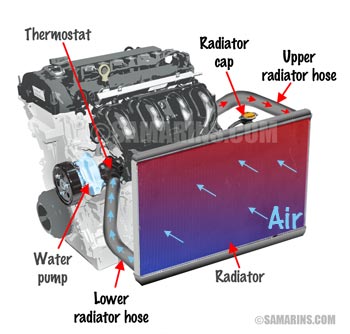
The thermostat is the key component of the engine cooling system. The cooling system keeps the engine from overheating. The system is filled with liquid coolant (antifreeze) and is connected into a loop with a radiator, see the diagram.

Cooling system diagram. Click for a larger image
The coolant flows through the engine where it absorbs the heat and into the top of the radiator. The radiator is built of many flat aluminum tubes surrounded by fins. The air passing through the radiator cools down the coolant as it flows down the radiator.
One or two electric fans attached to the back of the radiator turn on when needed to force more air through the radiator. A water pump pulls the coolant out of the radiator and pushes it back into the engine.
The normal operating temperature of a modern engine is between 194°F (90°C) and 221°F (105°C).
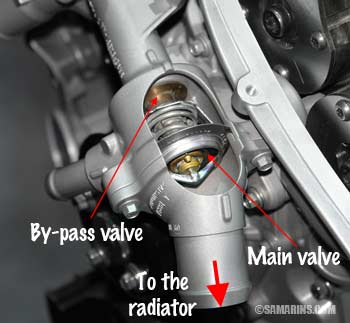
Thermostat inside the housing. Ford engine cutaway. Click for a larger photo
The job of a thermostat is to help the engine warm up faster and maintain the engine temperature above the minimum operating temperature (194°F or 90°C).
A conventional thermostat is a simple temperature-controlled two-way valve that opens at a specified temperature. In most cars, a thermostat is installed on the engine and is connected to the upper or lower radiator hose. Read how the thermostat works and see the diagrams below.
See a few examples: thermostat in a Ford 2.3L EcoBoost engine. This photo shows the thermostat housing in the Mazda 2.3L turbo DISI engine. This is a photo of a thermostat housing in the Dodge Charger SRT Hemi engine.
Symptoms of a bad thermostat can be divided into two types:
Thermostat stuck open: When the thermostat is stuck open, the engine temperature drops below normal when driving, especially on the highway in cold weather. A stuck-open thermostat can also cause a lack of heat from the heating system. The Check Engine light may come on too.
Thermostat stuck closed: When the thermostat is stuck closed, the engine might overheat. The thermostat may also need to be replaced if the thermostat housing is leaking coolant.
Yes, the thermostat that is stuck open is one of the possible reasons why it may take too long for the engine to warm up. The low coolant level can also cause the same problem. In many modern cars, however, it's normal.
AdvertisementMany late-model cars have smaller fuel-efficient engines. This means they burn less fuel and as a result, produce less heat. In addition, newer technologies that reduce friction inside the engine also reduce the amount of heat generated by friction.
In many newer cars it takes up to 20-25 minutes of driving before you can get decent heat going in winter. A heater may also not be as strong as in older cars with a larger engine. It's a trade-off for better gas mileage. As we mentioned, one sign that the thermostat is stuck open (or missing) is when the engine temperature drops below normal when driving on the highway in cold weather.
When dealing with any cooling system problem, the coolant level is checked first. Read more: how to check the coolant level.
In the old days, testing of the thermostat involved removing and heating it while submerged in water. At the temperature marked on the thermostat, it would start opening.
In modern cars, the operation of the thermostat is monitored by the engine computer (PCM). In most cases, if the thermostat is stuck closed or open, the Check Engine light will come on. The most common Check Engine light codes related to the thermostat are P0128 and P0126.
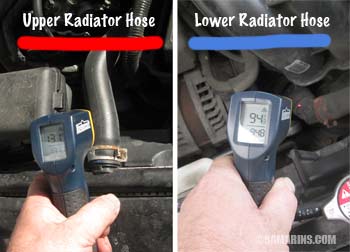
Mechanic measures radiator hose temperature with an infrared thermometer
Can you test the thermostat without removing it? Mechanics test the thermostat by measuring the temperature of the upper and lower radiator hoses with an infrared thermometer, while monitoring the engine temperature with a scan tool. See the chart below.
In this chart, the yellow line is the temperature of the engine, the red line is the temperature of the upper radiator hose and the blue line is the temperature of the lower radiator hose.
When the engine is started cold, the upper hose warms up with the engine, but since there is no flow through the radiator, the lower radiator hose remains cold.
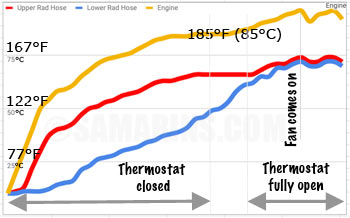
The engine is warming up at idle. The yellow line is the engine temperature. The thermostat opens at 185°F (85°C) and the temperature of the lower radiator hose (blue line) becomes almost the same as the temperature of the upper radiator hose (red line).
In this Honda in the chart, the thermostat starts opening at about 185°F (85°C). As the thermostat opens and coolant starts flowing through the radiator, the temperature of the lower radiator rises quickly close to the temperature of the upper hose. At about 204°F (96°C), the radiator fan comes on and the temperature drops a few degrees. The thermostat in this car is working properly.
If the thermostat was stuck open, the lower radiator hose would start warming up as soon as the engine is started.
If the thermostat was stuck closed, there would be no flow even after the engine reached the operating temperature, and the lower radiator hose would remain cool.
Of course, lack of flow through the radiator can be caused by many other reasons besides a stuck-closed thermostat. If the thermostat is stuck closed, the engine might overheat, which can result in expensive repairs. If there is a suspicion that the thermostat is stuck closed, it's usually replaced.
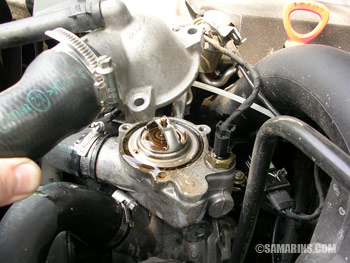
Replacing a thermostat
In an average vehicle replacing a thermostat may cost $150-370 parts and labor. In some cars, access to the thermostat is difficult, requiring more labor. The new thermostat usually comes with a new gasket. When the thermostat is replaced, the engine will need to be refilled with fresh coolant (antifreeze). The cooling system will need to be properly bled to remove all air pockets.
After servicing the cooling system, it's always important to verify that the fans come on when the engine is fully warmed up and the heating system inside the car can provide a good heat at idle. Lack of heat at idle can be caused by air pockets inside the cooling system.
Should the thermostat be replaced as part of regular maintenance? It's not necessary, however, it might be a good idea to replace a thermostat when the engine is rebuilt or replaced.
The thermostat is also often replaced together with a water pump, especially if they are located in the same area.
Some manufacturers recommend updating the engine computer software if the trouble codes that caused the Check Engine light are related to the thermostat, after it has been replaced.
Thermostat is closed:
When the engine is started cold, the thermostat (the main valve) is closed; there is no flow through the radiator. The smaller thermostat bypass valve is open and the coolant circulates through the bypass tube within the engine and through the vehicle's heating system. This allows the engine to warm up faster.
Thermostat is open:
As the engine warms up closer to the operating temperature, the thermostat valve gradually opens up, allowing coolant to flow through the radiator.
The coolant enters the top portion of the radiator and cools down as it flows through the radiator. The water pump pulls the cooled coolant back into the engine.
In cold weather, if the engine temperature drops close to the lower limit of the operating range (194°F or 90°C), the thermostat closes again.
Many modern cars use an electronically controlled valve called "coolant control valve" instead of a conventional thermostat. The coolant control valve works the same way only it's operated by the engine computer and is more precise.